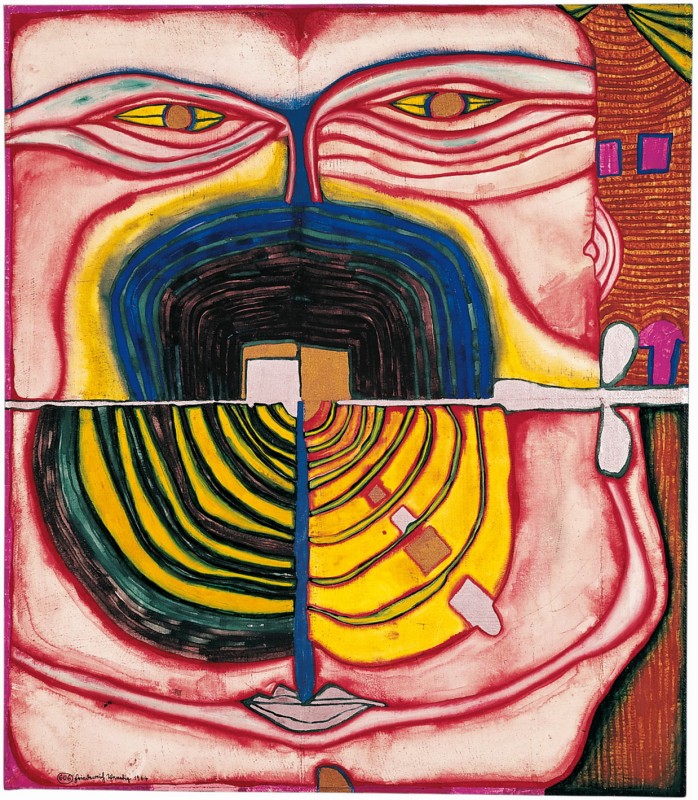606
HANA NO HANA - DIE NASENBLUME - KONRAD BAYERS TOD
Hana No Hana - The Nose-Flower - Konrad Bayer's Death
1964
Painted at Hagenberg, August 23, 1964 - mounted on hemp in Venice and finished October 19, 1964
570 mm x 500 mm
Mixed media: watercolour on drawing paper, primed with PV, mounted on hemp and painted over in parts with PV, oil, gold and silver bronze
- Hammerlunds Kunsthandel, Oslo, 1965
- *
- Travelling exhibition 1967:
- Galerie Karl Flinker, Paris, 1967
- Hanover Gallery, London, 1967
- Galerie Krugier / Galerie Georges Moos, Geneva, 1967
- Kunstverein Berlin, 1967
- W. Hofmann, Hundertwasser, Salzburg, 1965, cover (c), pl. 46 (c)
- Hundertwasser - Das Paradies liegt um die Ecke, Munich, 2002, p. 39 (c)
- A. C. Fürst, Hundertwasser 1928-2000, Catalogue Raisonné, Cologne, 2002, Vol. II, pp. 487/488 (and c)
- Art Souvenir - Hundertwasser, In the Colour of His Brush, London, 2016, pp. 44 (c), 91
- Hammerlunds Kunsthandel, Oslo, 1965, cat. 23
- Galerie Karl Flinker, Paris, 1967 (c)
- Hanover Gallery, London, 1967 (c)
- Galerie Krugier / Galerie Georges Moos, Geneva, 1967 (c)
- Haus der Kunst, Munich, 1975, p. 221 (c)
- Muzeum Narodowe, Warsaw, 1976, p. 221 (c)
- Seedamm-Kulturzentrum, Pfäffikon/Lake Zurich, 1979, p. 221 (c)
- Museum Ludwig, Cologne, 1980, p. 247 (c)
- Secession, Vienna, 1981, p. 247 (c)
- Kulturhaus, Graz, 1981, p. 247 (c)
- G. Rühm (ed.), Der sechste Sinn, Texte von Konrad Bayer, Rohwolt, 1965
- Kindlers Literaturgeschichte der Gegenwart, Munich, 1976, p. 213 (c)
- F. J. Raddatz, Süchtig nach Kunst, Regensburg, 1995, p. 10 (b)
- Morgenbladet, May 31, 1965, Oslo (b)
- Hundertwasser 2004 Calendar, Taschen, Cologne

Hundertwasser's comment on the work
I gave this picture the tentative title Hana No Hana. Hana means nose in Japanese, and hana also means flower. I know that so well because Yuko is Japanese. I painted the picture on August 23 at Hagenberg Castle, near the stove in Padhi's small room, while Konrad Bayer and the others were in the halls upstairs, with much music. Afterwards we all went to a kermis. It was Sunday. I was only there one day. The next day I left. Konrad was at my place in Venice on September 6. I showed him the finished picture. He liked it. He didn't know it depicted his death. I didn't either. Now that Konrad Bayer is no longer alive, I realise that this picture presaged his death. The way he died, too. There in his nose is the flower, whose noxious scent slowly spreads out in beautiful waves across his face. A face which in death is turning pale and pink and cold and bloated and flat and broad. The flower has already eaten through the nose and is turning the facial flesh outward. The blue gas is falling like snow on the eyelids. The eyes are narrowing and getting red rings of death. The nostrils, where the scent entered, are turning into the gates to the beyond. They are silver, gold and black, just as the funeral colours in Europe have unfortunately become. The pupils, too, have become small gold dots and the mouth a small silver slit, and the nose-flower has silver petals. The earth is also there already, and Mauer's purple priest's robes and church windows. I saw a colour photograph of Konrad Bayer's body. It was similar to my picture. Very. There were the red waves around the eyes and mouth. The part of the face below the nose was more swollen than above it. The wonderful flower was not visible, for it was inside. But a red rose was lying on the spotted skin. Now the picture is called Hana No Hana - The Nose-flower - Konrad Bayer's Death . Giudecca, November 30, 1964 (published in the first edition of Konrad Bayer's book "The Sixth Sense"; from: Catalogue Museum Ludwig, Cologne, 1980, p. 246 f.)